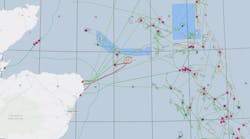Victor Schmidt
Houston
- Geco Tau delivered 1,700 sq km of processed 3D seismic to Conoco in 70 days. [24,137 bytes]
- Virtual reality interpretation allows professionals to "walk into" the data volume. [12,648 bytes]
Living in a virtual world
Oil is found in the mind, the most flexible virtual environment. Expanding silicon-based capability (computers) is now moving to augment this natural carbon-based capability (brains). Dealing with the increasing information flow requires new ways of "seeing" data sets to extract knowledge from them.3D seismic data compounds the issue by several orders of magnitude. Using computers, we can now create virtual environments to collect, store, process and present massive data sets. Virtual reality (VR) is a solution that is getting closer to the petroleum marketplace every day.
Recently, Statoil viewed VR presentations of the Stratfjord Field prepared at the Virtual Reality Environment Technology Laboratory (VETL). The VETL is headed by at Dr. R. Bowen Loftin at the University of Houston (Texas). Dr. Loftin and his team made presentations at Statoil's research center in Trondheim, at the Geoseminar in Haugesund, and at the head office in Forus, Norway. Seismic, geological and simulation models were shown in a four-walled "computer cave." The advantage of this new approach is the ability of professionals to walk "into" the data set and experience the data volume in full 3D, rather than projected 2D.
VR is widely used in medicine and entertainment. Soon, we will see it enter the petroleum industry in a major way for reservoir monitoring and evaluation, exploration and development, construction design, worker training, and simulations prior to actual construction or service work.
Shorter cycle pleases Conoco
Conoco has credited Schlumberger Geco-Prakla with helping the company achieve its goals. Geco delivered 1,700 sq km of processed 3D seismic in just 70 days after the final shot. The Trinidad survey was shot by the Geco Tau, which sent the data to the Houston Processing Center via satellite.This approach provided Conoco geophysicists with intimate involvement in the project from the start. "The quick turnaround of this project will assist us in meeting the short exploration cycle for this area of Trinidad," explains Conoco's Dan Bendig. The final products with AVO analysis will be delivered just 30 days after the post-stack time migration data.
Valhall Field 3D/4C survey
Amoco has awarded a contract to Schlumberger Geco-Prakla for a survey over Norway's Valhall Field. The 100-sq-km, 3D, four-component survey will be shot to overcome seismic interference problems caused by gas-charge sediments. The problem is a signficant one for the industry, especially in the North Sea.Fairfield delivers the BOX
Fairfield Industries began deliver of a new seismic system, BOX - The Seismic Data Net. It is a universal system with the capability to function in radio, cable, and stored data modes. BOX uses proven technologies from the hardware, software and cellular telephone industries to form a seamless "seismic data net" for all terrain types, including marine. Four of the first six systems will go to marine operations: two to China, one to Russia, and one to the Gulf of Mexico.800-block US Gulf survey underway
Bell Geospace began collecting 3D-FTG data over 800 Gulf of Mexico lease blocks. Called the "Epic Survey," the data set will provide detailed gravity information over four salt-rich areas: Mississippi Canyon, Ewing Bank, Green Canyon and Ship Shoal. The Secor Surf was refitted with Bell's 3D-FTG system as well as a Simrad EM 300 fathometer. The first 270 blocks will be ready for delivery by June 1998. Collection rate is expected to be eight blocks per day with survey completion scheduled for the end of 1998.1,000,000,000,000 operations per second
Petroleum Geo-Services (PGS) has reached a major milestone - 1 teraflop of worldwide computing capacity. The power provided by one trillion floating point operations per second is split between PGS's nine land and 14 onboard processing systems. Bjarte Bruheim, PGS' President and CEO, noted: "This is a significant first for the industry and represents a major step for PGS in our ability to help the oil companies in achieving their goals of reducing the cost and time required to provide high quality 3D seismic data." The need to both preprocess and preview 3D data sets collected by the high capacity Ramform vessels is driving PGS' need for this level of computing power.Landmark's OpenExplorer
Landmark Graphics has completed development of OpenExplorer, an information management technology that integrates data. "E&P managers have asked Landmark for an integrated solution to help manage local, regional, and enterprise-wide data, and to help shorten cycle times so asset teams have more time to spend on value-added interpretation activities," said Duncan Junor, Director of Integrated Information Management at Landmark. Robert P. Pebbler, President and CEO of Landmark, touts the software as highly scalable and an open platform for assembling, accessing, using, maintaining and securing data.Pumping more out of 3D earth-models
The emphasis at this year's Offshore Technology Conference geophysical section is to get more information from the 3D earth-model. Several papers will demonstrate recent advances in neural networks, professional teaming, 4D survey optimization, and onboard processing using satellite links to onshore centers.Also, geohazard topics are becoming critical issues for deepwater field development. High-resolution 3D survey descriptions, side-scan sonar, hydrates, and shallow water-flow control are hot topics. Gas hydrates will be examined for their future energy potential.
Copyright 1998 Oil & Gas Journal. All Rights Reserved.




